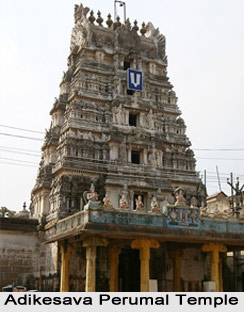 The inscriptions engraved on the temple walls reveal the chronological significance of the temple and provide other valuable information closely connected with the temple. Moreover the inscriptions engraved on the temple walls lend it a majestic grandeur and stately disposal. The oldest inscription found in the Sri Adikesava Perumal temple, dated 808 A.D. is one of the ancient epigraphs found on this temple. It seen on the south wall and belongs to the reign of the Pallava king Dantivarman. There are also many other inscriptions, which belong to the Pallava age of the 9th century A.D. The inscriptions depict the royal orders, which throw light on the functioning of the administrative organization called Sabha in the village. One of the most important inscriptions found in this village is a set of seven inscribed copper-plates of the 7th century A.D., the first portion of which is composed in Sanskrit particularly the Grantha script and the second portion is composed in the language of Tamil.
The inscriptions engraved on the temple walls reveal the chronological significance of the temple and provide other valuable information closely connected with the temple. Moreover the inscriptions engraved on the temple walls lend it a majestic grandeur and stately disposal. The oldest inscription found in the Sri Adikesava Perumal temple, dated 808 A.D. is one of the ancient epigraphs found on this temple. It seen on the south wall and belongs to the reign of the Pallava king Dantivarman. There are also many other inscriptions, which belong to the Pallava age of the 9th century A.D. The inscriptions depict the royal orders, which throw light on the functioning of the administrative organization called Sabha in the village. One of the most important inscriptions found in this village is a set of seven inscribed copper-plates of the 7th century A.D., the first portion of which is composed in Sanskrit particularly the Grantha script and the second portion is composed in the language of Tamil.
This inscription, significant enough narrates the tale that there lived a hundred and eight families that studied the four Vedas in Kuram (called Kura in this inscription) and that the Pallava king Parameshvaravarman I had made arrangements for the recitation of the Mahabharata at the Ishvara temple at this place. The village (grama) Kura was situated in the ancient territorial subdivision called Nirvalur in the district called Urukkattu Kottam. In this way the inscriptions engraved on the temple walls depict the administrative system of the Pallava kings and the rural society. Also it depicts the benevolent contribution of the Pallava kings for the upkeep of the temple.











